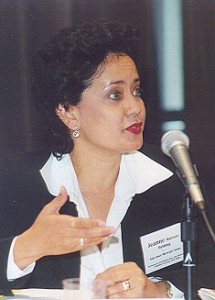As America Changes, Demography is Destiny
Silicon Valley, Miami, Washington exemplify ethnic swirls
In Santa Clara County, the home of California’s Silicon Valley, there is no mistaking the changing face of America. In 1970, the county was 82 percent white. Today, it is 48 percent white. And by 2025, that number will drop to 26 percent. In contrast, Asians were less than 2 percent of the county’s population in 1970. Today, they number close to 24 percent. And by 2025, Asians will comprise 38 percent of the population. Meanwhile, Latinos are as numerous as Asians – and growing in size.
How does a newspaper tell the story of such dramatic regional change? The San Jose Mercury News produced a five-part series entitled “A Majority of None,” focusing on what Jeanne Mariani-Belding, the race and demographics editor, called the “vast center” of the population. They are, she told the workshop, folks who seldom see their views in the paper but who, day by day, grapple with what the shifting demography means.
While The Mercury News was honored for its series on Santa Clara County, it also won acclaim for “Diaspora,” a series produced by Mariani-Belding and her team that took a pioneering look at Latino migration into America’s heartland. Similar workshop honors went to WTVJ-TV in Miami, for confronting the touchy issue of language and how it can both unite and divide a community; and to Gabriel Escobar of The Washington Post for his fresh, textured stories examining neglected aspects of Latino life in the nation’s capital and elsewhere.
In each case, the stories transcended the superficial. They guided readers and viewers over unfamiliar ground that surprised them, or over familiar terrain that still held surprises, and the journalists took risks in the process. “As the communities become more diverse and more complicated, one of the fundamental missions that we have is to make them at least understandable to each other and to the broader community,” said Escobar, now The Post’s city editor.
Escobar’s stories included an insightful article on how many Dominicans in New York City live in the complex and sometimes conflicted world of black Latinos, a racial group often ignored by news media. In another honored piece, Escobar described how local soccer leagues have become “the most visible manifestation of the Latino community at play.” But behind the scenes there is “a growing, cash-only business with few rules, a handful of impresarios, many bitter rivalries, no oversight and lots of talent, raw as well as accomplished.”
Escobar stressed the importance of elevating the coverage of immigrants. He argued that journalists should not only write more comprehensively about ethnic communities but also scrutinize them with a critical eye. “From experience, I know that doing these stories is very difficult,” he said. “News organizations do so few comprehensive pieces about the immigrant experiences that the natural tendency is to go soft and light when they are done. There is an inherent reluctance to do critical pieces, primarily because of the fallout that inevitably results.” While underscoring the need to do critical stories, Escobar noted that the “fatal flaw” of so many newspapers is that they fail to write regularly about Latinos and other communities. Thus, when a particularly critical story appears it cannot be placed in perspective.
In pursuing its “Majority of None” series, The Mercury News was faced with the task of writing a complex story that reflected not only the expanding influence of people of color – particularly Latinos and Asians – but also the contrasting loss of status by the long-established majority. “It was really a project that sought to tell the story of race relations and social change against a backdrop of whites losing their majority status,” said Mariani-Belding.
The newspaper began its research by bringing together focus groups – what Mariani-Belding called “extraordinarily ordinary people” – to tell the story of what the changes meant in their communities. Eventually, what evolved from those myriad discussions was a series told from the perspectives of five young high school students with diverse backgrounds.
In Miami, diversity is reflected in the city’s bilingual flavor and its richness in Latino immigrants from Cuba, El Salvador, Nicaragua and other Spanish-speaking countries. But Don Browne, president of WTVJ and a former NBC News executive, also saw a city polarized by language and by those who felt divided by a language they could not understand. “Language is a powerful and positive force,” he said. “It’s also a negative and dividing force in the community.”
In a kickoff piece entitled, “Does Anyone Here Speak English?” the station sought to examine the attitudes of people who felt uncomfortable when Spanish was spoken around them and who felt their lack of Spanish skills hurt them economically and socially in Miami. Heretofore, much of the evidence had been anecdotal, said Browne and Ramon Escobar, then WTVJ’s news director and now executive producer at MSNBC. “We needed real data,” Escobar told the workshop.
So in partnership with The Miami Herald, WTVJ conducted a poll measuring the attitudes of Latinos and non-Latinos over the issue of language. The station assigned two veteran reporters – one white and the other Latina – to the story. In this and subsequent reports, assumptions about the language rift “were clearly blown apart,” Escobar said. For example, he pointed to the belief that the influx of Spanish-speaking immigrants had caused white flight northward from Miami. “Actually, Hispanics were moving north,” he said.
In the end, WTVJ ran more than a half dozen stories and conducted a spirited town meeting. The work was often controversial (“When you’re over the target, you get flak,” Browne quipped). It also won critical acclaim and a sizable share of viewers. “However you feel about diversity, diversity is good business,” Browne said, “and provocative television that reflects your community can be successful.”



